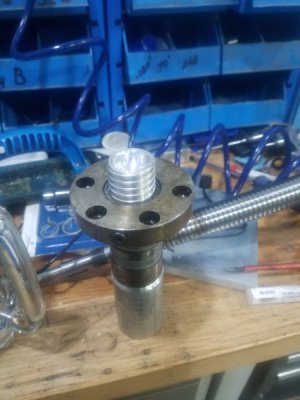R
Robert LaLonde
Forum Guest
Register Today
Ball Nut Holder - I am sure somebody can tell me why this is a stupid idea, but I needed to get this ball nut off the ball screw without dumping the balls all over the floor. I don't know if the screw is salvageable or not. Its got a bend in it somewhere. If its just in the machining in the end I might be able to turn it down and machine some bushings. If the screw is bent in the main span its done. I might be able to straighten that, but it wouldn't be very accurate anymore. Normally guys screw the nut off onto a piece of cardboard tube, but I have bad luck with that. This hand made stub of aluminum "ballscrew" mates up with the end of the ballscrew I need to check, and I was able to just screw the nut off onto the stub. I had to hand grind a radius tool out of HSS in order to thread the holder. It took me a couple hours, but it worked out perfectly. Of course that time is wasted except for the learning experience if I can't save the screw.
Anyway, now I can roll the screw on my granite surface plate and determine where its bent.

Anyway, now I can roll the screw on my granite surface plate and determine where its bent.

Last edited by a moderator:

